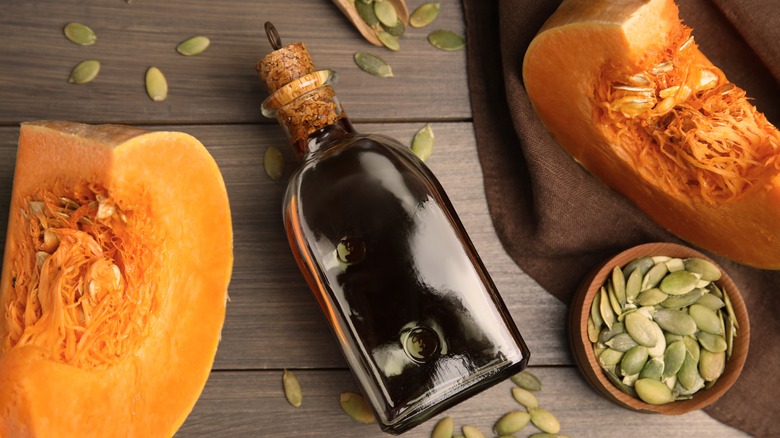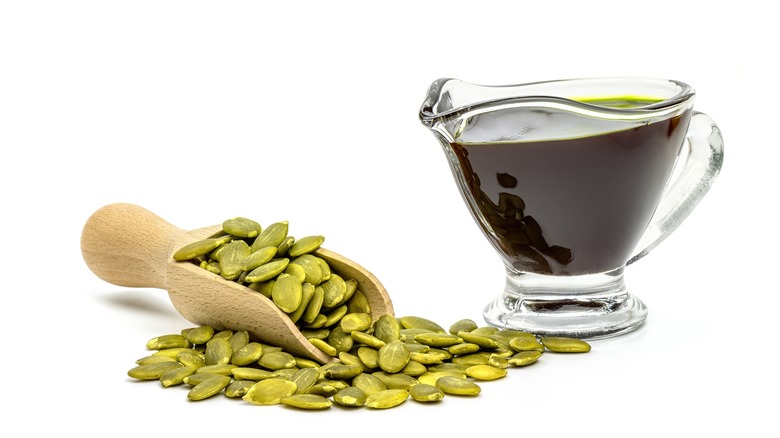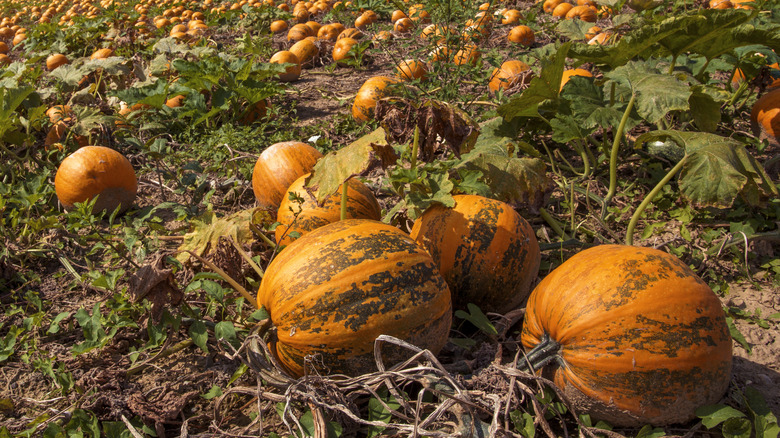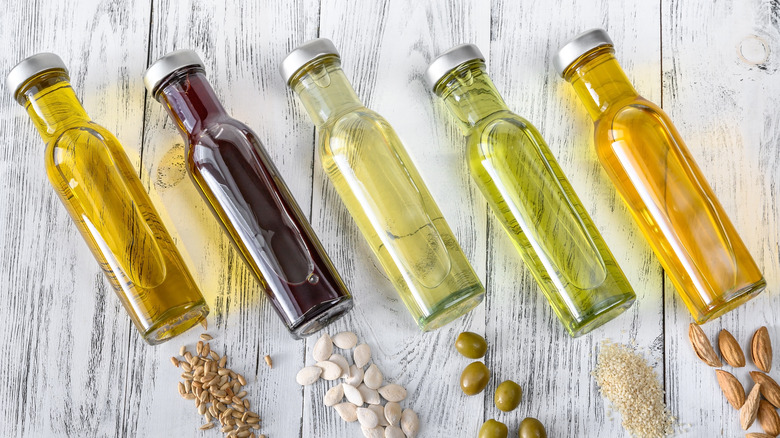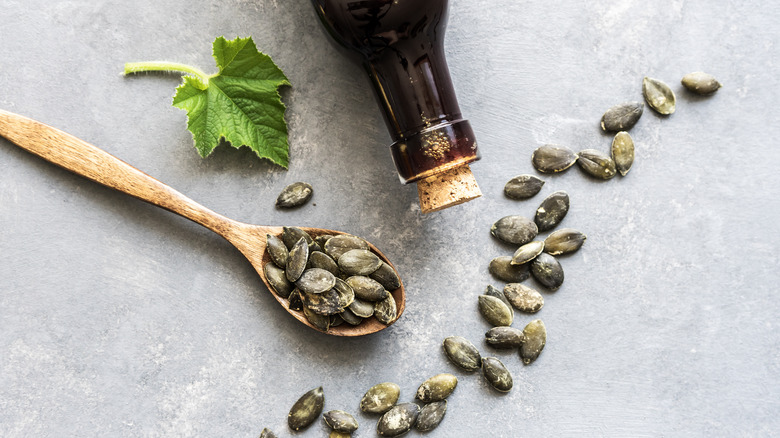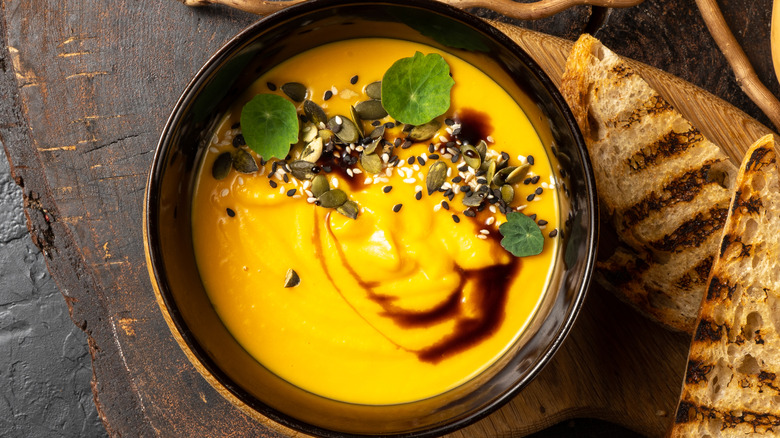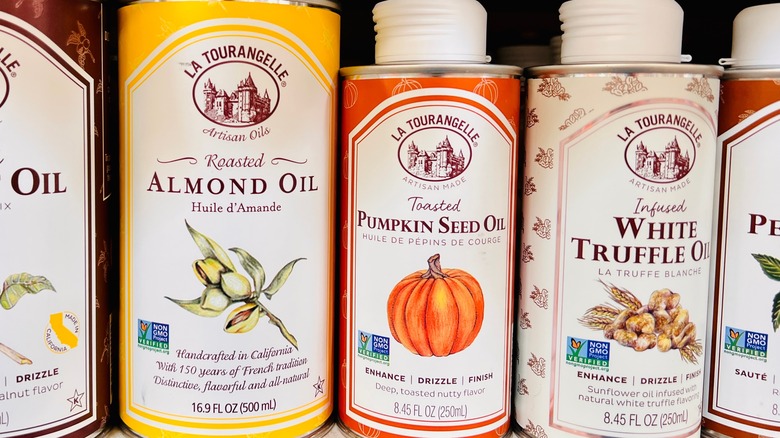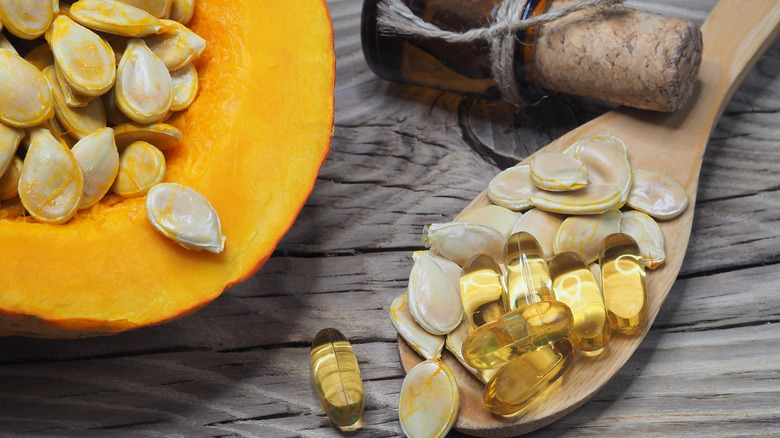Pumpkin Seed Oil Is The No-Cook Ingredient For Enhancing Dishes
Pumpkin seed oil merits a place in your pantry. While you probably have a few bottles of oil already kicking around, such as vegetable for frying, olive for sautéing, and perhaps another of something more niche like sesame to drizzle over salads, this is more than justified. Why? Each serves a very different (and particular) function. By the same methodology, should you want to introduce a finishing oil — and an extraordinary one at that — to your roundup of culinary fats, then look no further than pumpkin seed oil.
Oils aren't all made the same. Their characteristics can be vastly diverse, making certain varieties better suited for specific gastronomic applications than others. When it comes to the lesser-known pumpkin seed oil, its low smoking point and dramatically vibrant profile make it a knock-out ingredient when served as is. Giving meals a last-minute makeover, pumpkin seed oil is the garnish you didn't realize you needed until now.
What is pumpkin seed oil?
A culinary oil that's made from pumpkin seeds, the ingredient is exactly what it sounds like. Though it's not traditionally been one of the most common cooking companions in the U.S., pumpkin seed oil is a favorite ingredient in central European countries like Austria, Slovenia, Croatia, and Hungary, where it's been embraced in cuisine for centuries.
Pumpkin seed oil holds the power to add color, flavor, and textural richness to any dish. Yet, its sheer intensity is what makes it stand out against other finishing oils. In addition to its strikingly deep green hue, it has a dense and almost syrupy consistency when poured, its fragrant aromas leaving predominantly toasty notes. These attributes, of course, are all thanks to the oil's very unique source.
Extracted from the hull-less seeds of the Styrian pumpkin (Cucurbita pepo L. Styriaca), the varietal is native to the Austrian region of Styria. At a glance, the orange and green-striped pumpkin looks quite ordinary. However, its interior reveals a dark green center hiding heaps of tear-shaped seeds teeming with complex flavor that will eventually be transformed into delicious pumpkin seed oil.
How is pumpkin seed oil produced?
The process starts with sowing pumpkin seeds early in the spring. During the summer, gourds sprout and grow without much intervention. It isn't until autumn that ripe, bronzy pumpkins can finally be plucked from their tangled vines, and traditional Styrian pumpkin seed oil can be produced.
To achieve PDO status, the pepitas (the name given to hull-less seeds) are manually or mechanically removed. Next, they are cleaned and dried before being milled, which entails finely grinding the pepitas into a thick and grainy paste. This paste is then mixed with water and salt to improve extraction by drawing out fat from the proteins and oil from the seeds. However, the paste must first be roasted. A task requiring great skill, roasting is done slowly at low temperatures to develop the oil's iconically nutty profile.
Once roasting is complete, the paste is pressed under the immense pressure of a cylindrical mechanical press. The freshly pressed pumpkin seed oil is left to settle before being bottled and sold. Laborious as processing may be — on average, it takes about five large pumpkins to make a single cup of pumpkin seed oil — the end product is worth every step to obtain the velvety and aromatic "green gold."
Pumpkin seed oil vs. other seeds oils
First and foremost, one of the significant aspects that makes pumpkin seed oil so unique is its low smoking point. Unlike other seed oils, such as sunflower or canola, which can withstand temperatures up to 450 degrees Fahrenheit, pumpkin seed oil has a smoke point of only 320 degrees. As a result, this means that it's best suited for low-heat applications, especially when used as a finishing oil.
Additionally, the flavor of pumpkin seed oil is quite distinct compared to other seed oils. For example, although many seed oils are fairly neutral in aroma and flavor, pumpkin seed oil offers a bolder alternative. Naturally, this profile, paired with its vibrant green hue, is another thing that makes the oil starkly different from any paler, yellow-toned seed oils. Last but not least, pumpkin seed oil also boasts many nutritional benefits, but we'll get to that in a moment.
What does pumpkin seed oil taste like?
Just as fragrant as it is flavorful, pumpkin seed oil proves its worth as an ingredient. In addition to offering a luxuriously smooth mouthfeel and dimension of decadence, the green oil is full of aromatic and gustatory depth. Evidently, if you prefer drama in every bite, then this is undeniably the finishing oil for you.
Since Styrian pumpkin seeds are recognized for their earthy and almost smoky undertones, it's not surprising that after being processed, this umami quality is still emphasized. Offering a deeply toasted quality, pumpkin seed oil borders somewhere between buttery and nutty. On the palate, it's slightly reminiscent of sesame oil but with a more pronounced flavor of roasted nuts — even more than you might expect from a nut-based oil. However, pumpkin seed oil still maintains the same degree of richness and warmth as other squash seed oils.
Regardless of how fabulously inviting the oil may seem, often it can also have a slightly bitter quality, which can be accentuated with heat. Consequently, knowing how to properly use pumpkin seed oil is essential.
How to cook with pumpkin seed oil
Pumpkin seed oil will make anything taste better, and that's a guarantee. It adds color, it adds taste, and it adds texture to any dish that lacks pizzazz. Think of it like a condiment or, better yet, a garnish. Add a drizzle (any more and it may be too overwhelming!) over any dish before serving, and get ready to bask in all of its deliciousness. Unsure where to start?
There's nothing to stop you from serving Styrian pumpkin seed oil with a slice of good bread, but there are also a myriad of savory ways to use the green gold. For instance, a dash of pumpkin seed oil is the perfect final touch when added to soups, pizzas, grilled vegetables, roasted meat, poached fish, pasta sauces, and even a butternut squash risotto. It can also be whisked into vinaigrettes or swirled into savory spreads like pesto for an added burst of flavor. Plus, you can also add it to recipes where oil isn't subject to heat for an extended period of time, like scrambled eggs.
For those with a sweet tooth, pumpkin seed oil pairs stunningly with desserts. In fact, its nutty profile makes it a no-brainer to use in baked goods like cakes and strudels. It can also be drizzled over sugary baklava to counteract sweetness with savoriness. Not to mention that umami-driven pumpkin seed oil can also make the ultimate topping for decadent offerings like creamy gelato, frozen custard, or cheesecake.
Where to buy pumpkin seed oil
Admittedly, pumpkin seed oil isn't the easiest oil to track down, but it's not impossible. Brands like La Tourangelle can usually be found in supermarkets wherever oil or condiments are kept — it might even be hiding in the health food section. Alternatively, specialty food stores and online retailers will also carry a range of artisanal pumpkin seed oils.
To ensure the highest quality oil, it's best to choose varieties that are packaged in small containers, specifically opaque tins or dark bottles, as this will limit the risk of rancidity. As for labels, those marked with the European Union's Protected Designation of Origin (PDO) seal will guarantee the most authentic Styrian versions. Likewise, bottles labeled "cold-pressed" or "100% pumpkin seed oil" will also indicate a high quality.
Lastly, seeing as pumpkin seed oil can reach upwards of $20 for an 8-ounce bottle, the cost can also be a good indicator of quality. That said, with such a hefty price tag, knowing how to properly store the oil can help you make the most out of it. Ideally, pumpkin seed oil fares best when kept somewhere cool, away from direct heat or sunlight. Additionally, the bottles should always be tightly closed between uses so as to ensure the oil lasts well beyond the typical 9-month mark, at which point, colors will brown, aromas will dull, and flavors will fade.
The health benefits of pumpkin seed oil
The benefits of pumpkin seed oil don't stop at flavor. Green gold has long been praised by Austrians for its medicinal value. Far from myth, there is some truth to the matter, as pumpkin seed oil is actually a great source of healthy fats, which is key to maintaining a balanced diet. When consumed in moderation (about a single tablespoon daily), the oil can keep the body working in tip-top shape, and here's how.
According to Healthline, pumpkin seed oil is loaded with omega-6 fatty acids, can support heart health, as well as help maintain optimal blood sugar levels. It also promotes urinary tract health, particularly when it comes to prostate and bladder function. Plus, pumpkin seed oil is teeming with antioxidants like polyphenols and carotenoids, which work to reduce inflammation in the body, as well as combat chronic illness. It's even been known to increase hair growth when applied topically.
Although you can easily incorporate a spoonful of Styrian pumpkin seed oil into your diet through various recipes, for those strictly seeking benefits, it can also be found as a supplement in capsule form. However, we recommend taking full advantage of the liquid's unique flavor profile — this oil was meant to be savored!
